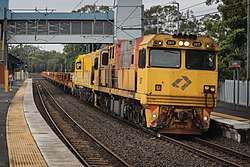Queensland Railways 2800 class
The 2800 class are a class of diesel locomotive built by A Goninan & Co, Townsville for Queensland Rail between 1995 and 1998.
| Queensland Railways 2800 class | |||||||||||||||||||||||||||||
|---|---|---|---|---|---|---|---|---|---|---|---|---|---|---|---|---|---|---|---|---|---|---|---|---|---|---|---|---|---|
 2817 at Carseldine station in Brisbane in 2019 | |||||||||||||||||||||||||||||
| |||||||||||||||||||||||||||||
| |||||||||||||||||||||||||||||
| |||||||||||||||||||||||||||||
| |||||||||||||||||||||||||||||
They are currently owned by Aurizon and operate on the North Coast and Mount Isa lines.
History
The 2800 class were ordered to haul passenger and freight services on the North Coast line between Rockhampton and Cairns and on the Great Northern line between Townsville and Mount Isa. The initial order for 40 was later increased to 50.[1] However a miscommunication resulted in the builder's plates incorrectly being stamped as 202 to 211 which had been used by other A Goninan & Co locomotives, rather than the correct 323 to 332.[2]
They now operate trains as far south as Brisbane. They are the only double ended diesel electric locomotives to have been built for Queensland Rail.[3][4][5]
In February 2006, one locomotive was fitted with standard gauge bogies for use by QR National in New South Wales and Victoria, but the NSW Environment Protection Authority refused permission for it to be used in that state due to excessive noise emissions.[6] In August 2009 it was converted back to narrow gauge for use in Western Australia.[7] In 2013 three were reclassified as the 3200 class for use in NSW, following the installation of standard gauge bogies and a modified exhaust system that reduced low frequency noise emissions.[6]
In 2015, 2814 derailed on the Mount Isa Line at Julia Creek, spilling sulphuric acid. 2814 flipped on its side and was deemed too damaged to repair, and as such was scrapped in 2017.[8]
References
- "2800 Class Contract Extended" Railway Digest August 1996 page 11
- "Queensland Rail 2800 Diesel Locomotives" Australian Railway Historical Society Bulletin volume 737 March 1999 pages 112-113
- 2800 Class Great Queensland Trains
- Goninan/GE 2800 Class Queensland's Railway Interest Group
- 2800 Class Railpage
- Briony Croft; Steve Brown; Aaron Miller; Andrew Parker (2014). "Exhaust noise control case study for 2800 class locomotive" (PDF). SLR Consulting. Retrieved 28 December 2014.
- PA Class (diesel, WA) Railpage
- "Freight train carrying sulphuric acid derails near Julia Creek". ABC News. 27 December 2015. Retrieved 28 July 2019.